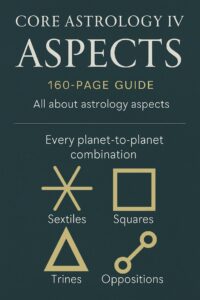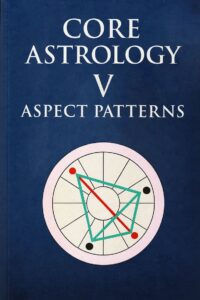Aspects in Astrology
Conjunction
Indicates the merging of energies between two planets or chart elements. Depending on the qualities of the participants, this can be supportive or more difficult and restrictive. For example, a Mars–Venus conjunction increases enthusiasm for activity, while a Mars–Saturn conjunction may make it harder to get started or feel motivated but it also provides greater endurance.
Trine
The easiest and most fortunate aspect, formed when planets are in the same element. Their energies naturally support each other so smoothly that we often don’t even realize how beneficial this unity truly is.
Sextile
Often described as the “little sibling” of the trine, the sextile indicates supportive opportunities. Because the planets are in signs of the same polarity, they can cooperate, but it requires conscious effort and attention to activate the potential.
Square
Connects signs of the same modality (cardinal, fixed, or mutable), which generates tension and challenges. The difficulty lies in the inner conflict: one part of us wants to act one way, while another part wants the opposite. This creates extra energy, which can fuel motivation to overcome obstacles. Other aspects may help ease the friction, but if they are absent, greater conscious effort is needed to use the conflicting energies constructively often by seeking people or environments that help channel the tension.
Opposition
Like the square, it signals tension, but it also widens perspective by requiring us to reconcile opposing viewpoints. A key trait of oppositions is projection: we often see one pole in others or in the outside world before we can integrate it within ourselves.
Quincunx
Formed when planets are five signs apart. It represents a kind of forced interdependence that is slower to become conscious. It is an educational aspect, similar in effect to an opposition. Its complementary minor aspect is the 30° semi-sextile.
Other less common or minor aspects (usually interpreted only with a 1–2° orb):
Semi-square (45°): Indicates conflicts that can be resolved in this lifetime, but without a compelling or urgent force behind them.
Sesquiquadrate (135°): A more relaxed version of the square, making its challenges easier to work with and integrate.
Quintile (72°): Represents talent or special ability, which may remain latent unless consciously developed. Its complementary aspect is the 108° tri-decile.
Bi-quintile (144°): Suggests manifest talent or a natural ability that is more readily expressed.
Tri-decile (108°): Indicates extra creativity, inspiration, and originality.
Novile (40°): Associated with sacrifice or self-offering.
Septile (51.43°): Can point to inspiration, mystical inclinations, or a sense of spiritual calling.
Bi-septile (103°): Suggests confrontation with one’s destiny or life task, often involving a sense of self-reliance.
Quindecile (165°): May indicate compulsions, obsessions, or an intense, fixated drive.
Aspect Patterns
Aspects can form more complex patterns when multiple planets are involved. Here are some of the most well-known:
Grand Trine
Formed by three planets connected through trines. It provides stability and endurance, though without more challenging or activating aspects it may also lead to complacency or laziness.
Sextile–Trine (Minor Talent Triangle):
One planet forms sextiles with two others, while those two are in a trine with each other. This pattern allows the planets to cooperate smoothly and often brings new opportunities.
Kite
A Grand Trine in which one of the planets is opposed by a fourth. This creates more activity and drive than the Grand Trine alone.
T-Square
One planet forms squares to two others, while those two are in opposition. It creates tension, pressure for action, and a sense of imbalance.
Grand Cross (Square Cross)
Four planets form squares to each other in a cross-shaped pattern. This generates significant, ongoing tension and requires continuous effort and adaptation.
Trapeze
A flexible configuration that can be made up of various aspects. Its meaning depends on the exact structure; it may be based on an opposition or a trine.
Wedge (or Softened Opposition)
An opposition between two planets that is eased by a third planet forming a trine to one and a sextile to the other.
Mystic Rectangle
Formed by two Wedges combined. It is considered beneficial and can indicate esoteric or spiritual abilities.
Yod (Finger of God)
A highly dynamic, fated pattern that calls for reorganization and transformation. Two planets are quincunx to a third, while they form a sextile with each other

